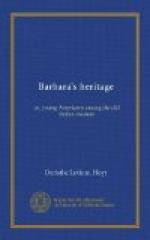“This beautiful church just here on our right,” continued Mr. Sumner, “is the church of the S.S. Annunziata or the most Holy Annunciation. It was founded in the middle of the thirteenth century by seven noble Florentines, who used to meet daily to sing Ave Maria in a chapel situated where the Campanile of the Cathedral now stands. It has been somewhat modernized and is now the most fashionable church in Florence. It contains some very interesting paintings, which we will visit by and by.”
“Every step we take in this beautiful city is full of interest, and how different from anything we can find at home!” exclaimed Bettina. “Look at the color of these buildings, and their exquisite arches! See the soft painting over the door of the church, and the sculptured bits everywhere! I begin, just a little, to see why Florence is called the art city.”
“But only a little, yet,” said Mr. Sumner, with a pleased look. “You are just on the threshold of the knowledge of this fair city. Not what she outwardly is, but what she contains, and what her children have wrought, constitute her wealth of art. Do you remember, Margery, what name the poet Shelley gives Florence in that beautiful poem you were reading yesterday?”
“O Foster-nurse
of man’s abandoned glory,
Since Athens, its great mother,
sunk in splendor,
Thou shadowest forth that
mighty shape in story,
As ocean its wrecked fanes,
severe yet tender,”
dreamily recited Margery, her sweet face flushing as all eyes looked at her.
“Yes,” smiled her uncle. “Florence, as foster-nurse, has cherished for the world the art-treasures of early centuries in Italy, so that there is no other city on earth in which we can learn so much of the ’revival of art,’ as it is called, which took place after the barrenness of the Dark Ages, as in this. But here we are at the Academy. I shall not allow you to look at much here this morning. We will go and sit in the farther corner of this first corridor, for I wish to talk a little, and just here we shall find all that I need for illustration.”
“You need not put on such a martyr-look, Malcom,” continued he, as they walked on. “I prophesy that not one here present will feel more solid interest in the work we are beginning than you will, my boy.”
When Mr. Sumner had gathered the little group about him, he began to talk of the beauties of Greek art—how it had flourished for centuries before Christ.
“But I thought Greek art consisted of sculptures,” said Barbara.
“Much of it was sculptured,—all of it which remains,—but we have evidence that the Greeks also produced beautiful paintings, which, could they have been preserved, might be not unworthy rivals of modern masterpieces,” replied Mr. Sumner. “After the Roman invasion of Greece, these ancient works of art were mostly destroyed. Rome possessed no fine art of her own, but imported




